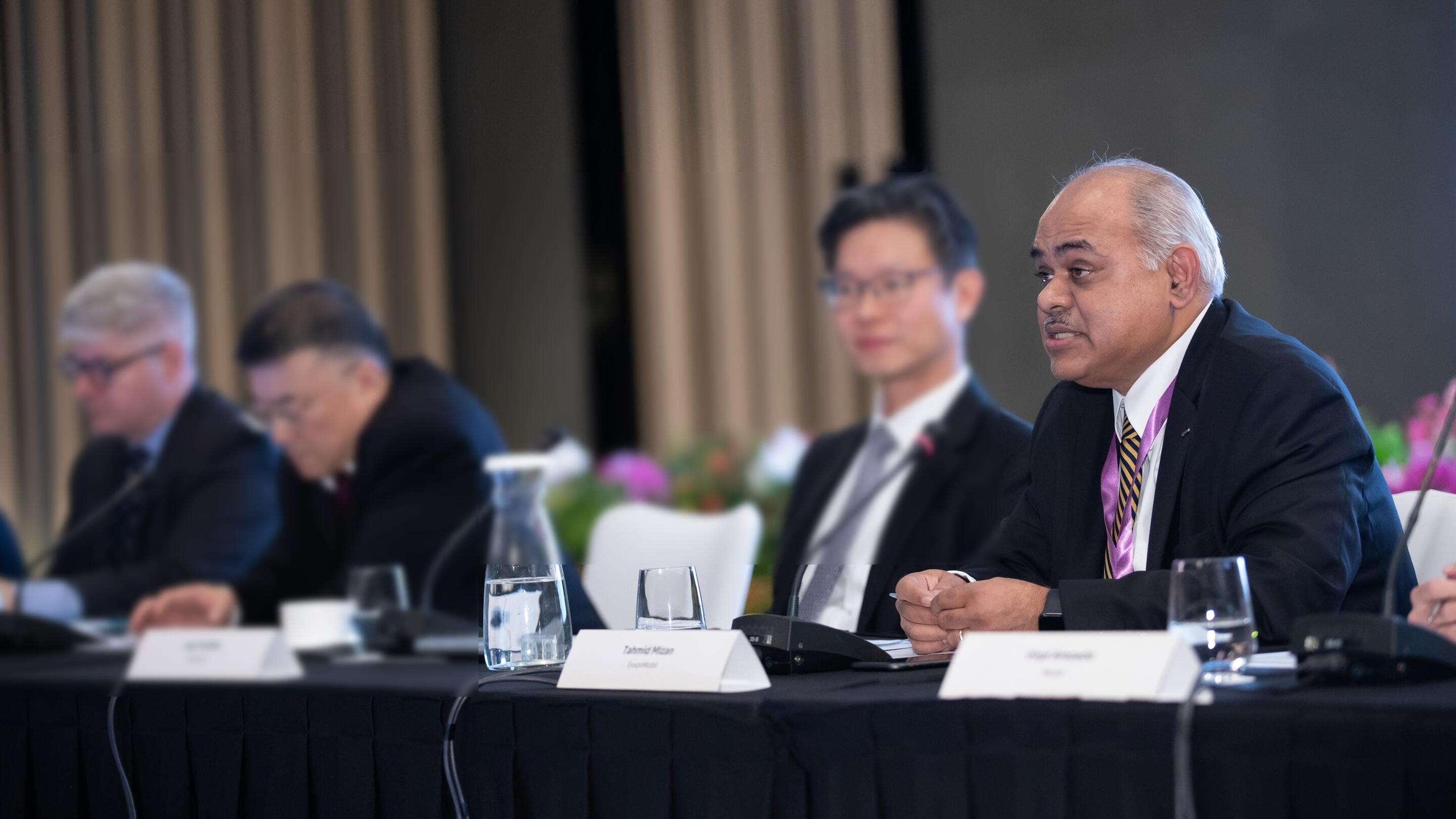3 min read
Our operations
3 min read
Navigate to:
We own and operate a 592,000-barrel-per-day (bpd) refinery, which is fully integrated with the Singapore Chemical Plant (SCP). Together, they form our world-scale operations right here in Singapore.
Our facilities have the flexibility to process a range of feedstocks depending on market conditions. The sites are also fully integrated through a network of pipelines that exchange various feedstocks and product streams.
Energy efficiency and reducing emissions are key focus areas of our operations. We have invested in three cogeneration facilities at our Singapore Complex, which can generate around 440 megawatts of electricity. These units provide power and steam to our facilities, significantly increasing the site’s energy efficiency.
Refinery
Spanning two operating sites, the Singapore Refinery is made up of the former Mobil and Esso refineries which operate as one facility following the merger of Exxon and Mobil in 1999.
Mobil built its refinery in Jurong (Pioneer Road) in 1966, while Esso started up at Pulau Ayer Chawan (now part of Jurong Island) in 1970. Pipelines connect the two sites to enable seamless operations and effective molecule management.
With a combined nameplate capacity of about 592,000 barrels per day, the Singapore Refinery produces a range of fuels, base oils for industrial and automotive lubricants, waxes, and aromatics that are marketed within Singapore as well as exported to countries in the Asia-Pacific.
Construction is progressing on the Singapore Resid Upgrade Project, which will improve the competitiveness of the integrated complex. It’s on track to start up in 2025 to help meet the growing demand for high-performance lubricants and clean fuels such as ultra-low sulfur diesel.
Chemical plant
This world-scale petrochemical complex was first commissioned in 2001 and was further expanded to more than double its capacity in 2013. This was followed in 2017 by an acquisition of one of the world’s largest aromatics facilities, known as SCP’s Banyan facility, and the completion of two world-scale production units for hydrocarbon resins and halobutyl rubber.
The chemical plant has an ethylene production capacity of 1.9 million tonnes per year.
The site produces commodity and performance plastics, modifiers and tackifiers, butyl rubber, aromatics and oxo alcohol. These materials play a key role in the manufacture of everyday products, including automotive parts, cosmetics and food packaging.
Lubricant plant
The lubricant plant produces a wide range of mineral and synthetic products for passenger vehicles, commercial vehicles, industrial and marine applications, and wind turbines.
The plant is ExxonMobil’s largest in Asia Pacific for greases and our flagship Mobil 1TM engine oil, serving customers here in Singapore and over 30 countries and territories worldwide.
Fuels terminal
ExxonMobil operates a fuels terminal and liquefied petroleum gas (LPG) bottling plant in Jurong. The terminal serves as an interface between the refinery, service stations, and some of our commercial customers. It loads bulk trucks with petrol (gasoline), diesel, renewable diesel and light fuel oil.
The LPG bottling plant fills cylinders that are seen across Singapore, providing fuel for cooking.
Safety and emergency response
At ExxonMobil, we are committed to safeguarding the health of our employees, contractors, customers and the public. Safety is a core value and an integral part of ExxonMobil’s culture.
Our operational risks are managed through our Operations Integrity Management System (OIMS). This framework establishes common worldwide expectations for addressing safety, security, health, environmental, and social risk in every aspect of our business.
We are a part of industrial neighborhood networks such as the Sakra Owners Round Table on Jurong Island, and the Jurong Neighbourhood Environmental Safety and Health (NESH) network. The NESH network is initiated and led by ExxonMobil to promote the sharing of best practices in safety, health and environment among industrial neighbours.
In addition, ExxonMobil maintains a strong emphasis on training and preparation for emergency response. In the event of an incident happening, we are ready to respond with trained staff and resources including an in-house fire team and global response teams. Our Singapore complex periodically conducts drills and joint exercises alongside government agencies, such as the Singapore Civil Defence Force (SCDF), to ensure preparation and coordination.
Learn more about ExxonMobil’s commitment around the world to operations integrity here.
Understanding flaring
Flares are important safety devices used in refineries and petrochemical facilities. They safely burn excess hydrocarbon gases which cannot be recovered or recycled. Excess hydrocarbon gases are burnt in the flare systems in an environmentally-sound manner, as an alternative to releasing the vapour directly into the atmosphere.
During flaring, excess gases are combined with steam and/or air and burnt off to produce water vapour and carbon dioxide. The process is similar to the burning of liquefied petroleum gases (LPG), which some of us use as fuel for home cooking.
The use of flares is minimised to the extent that is possible. However, flaring can occur during facility maintenance or during unplanned operational interruptions such as power outages.
When there is flaring at our facilities, we follow established guidelines to promptly inform our neighbouring companies and government agencies such as the National Environmental Agency (NEA) and the Singapore Civil Defence Force (SCDF).
There are generally two types of flares that we use at our Singapore manufacturing facilities:
- Elevated flares, where the flare tip is between 20 to 150 meters above ground.
- Ground flares, where the flare tip is about two to three meters above ground, which is fenced off with a high heat-shield fencing, which also acts as a safety zone.
What can sometimes be seen or heard in instances of flaring?
A flame or a glow:
- The elevated flare appears as a flame on top of a tower.
- The ground flare is not visible in the day, but at night, it may cast an orange glow in the night sky, depending on cloud cover.
Smoke:
- Sometimes, a white cloud may be observed around the flare. It is actually steam that is injected into the flare system to help achieve complete combustion and smokeless flaring.
- On some occasions, there may be black smoke from the flare. While we strive to achieve smokeless flaring, it may not always be possible during operational situations.
Noise:
- Flaring may produce a rumbling noise. It may sound like thunder.
- This is due to the turbulent mixing of gases, air and steam. The sound is like what you hear when you fan a campfire, and oxygen is mixed with the flame.
ExxonMobil is committed to ensuring that our operations run safely and with minimal impact on the community and the environment. We strive to minimise flaring, keeping it to the times that it is necessary for the continued safe operations of our plants.
When you see flaring, please be assured that flares play a key role in keeping refineries and chemical plants running safely.
Explore more
ExxonMobil enters agreement with Chandra Asri Group to sell service station network in Singapore
ExxonMobil starts first-of-its-kind technology in Singapore
2 min read
• Sept. 23, 2025
Driving positive change faster with policy
2 min read
• July 17, 2025
Tip for dads: Be present and intentional
2 min read
• June 10, 2025
Decide on your priorities and live by them: Mother's Day tip from Pei Theng
3 min read
• May 9, 2025
Why we give: The people behind our blood drive in Singapore
2 min read
• April 4, 2025